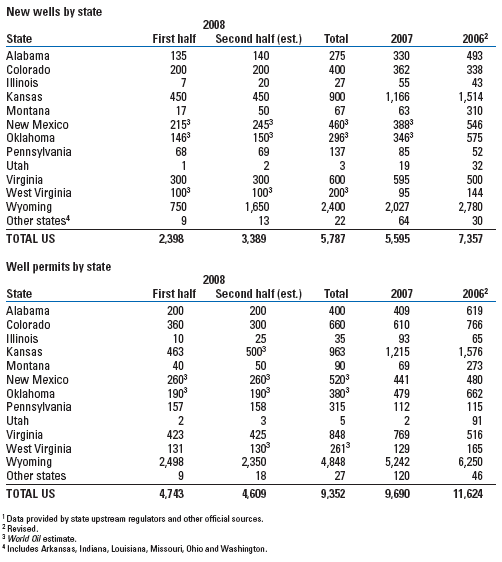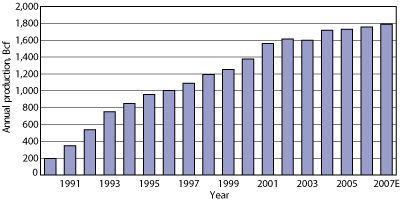After falling precipitously for the first time in 2007, US CBM faces an uncertain year.
David Michael Cohen, Production Engineering Editor
Though North American coalbed methane production maintained modest growth in 2007, CBM drilling took a precipitous and unprecedented dive as lower gas prices, high dewatering costs and slow permit turnaround took a toll on development of this unconventional gas resource.
US CBM activity. As predicted by World Oil last year, US coalbed methane drilling took a 24% plunge in 2007 to 5,595 wells from a revised 2006 number of 7,357, according to data reported by regulatory officials in CBM-producing states, Table 1. Permitting dropped for the second consecutive year, to 9,690 permits from a revised figure of 11,624 permits in 2006. However, 2008 is showing signs of a slight rebound. In the first half of the year, 2,398 wells were drilled, 27% higher than the 1,889 reported in first-half 2007, even though first-half 2008 permitting was slightly lower than last year. Overall, 2008 drilling is expected to flatten out at 5,787 wells, just slightly up from last year, though there will be about 3% fewer permits for the year, at 9,352. The 2008 drilling forecast is highly conditional, chiefly on political developments in Wyoming.
| TABLE 1. US coalbed methane wells and permits1 |
 |
|
There continue to be multiple challenges to collecting CBM statistics, including long time lags in reporting completions and discrepancies in how states categorize gas wells targeting both coal seams and conventional gas deposits. Some state agencies still do not count CBM wells separately from overall gas wells.
Wyoming continued to drill the most CBM wells in the nation-2,027-in 2007, but that was 27% fewer than the state drilled in 2006, and accounted for about 43% of the overall drop in US CBM drilling.
Don Likwartz, director of the Wyoming Oil and Gas Conservation Commission, blames the slowdown largely on permitting delays. He says the US Bureau of Land Management (BLM), which controls 65% of the minerals in the CBM-producing areas of the Powder River Basin, is taking longer than 400 days to issue a CBM drilling permit. In addition, he said, the Wyoming Department of Environmental Quality is taking an average of 6-9 months to approve water handling permits, with the result that about 4,300 CBM wells have been drilled but have never produced any water or gas. The state agency’s delays are largely due to a legal dispute with neighboring Montana, which set numeric water anti-degradation standards in 2006 that Wyoming and CBM producers say are excessively restrictive. Discharge water from Wyoming CBM wells flows into the Powder River and north into Montana.
Other factors in the state’s CBM drilling slowdown include infrastructure delays and a low local gas price due to a lack of pipeline capacity. “It’s taking about 1-2 years to get power, compression and pipelines installed to the wells,” Likwartz said, adding, “Opal Wyoming gas prices are still $3/Mcf lower than Henry Hub, [and] CBM gas prices are $1-$1.25 lower than Opal.”
Likwartz said 2008 drilling will also be adversely affected by a BLM plan-announced May 19, 2008, by the agency’s Buffalo, Wyo., field office-to prohibit drilling in areas that contain nests or breeding grounds of the sage grouse, whose population has fallen in recent years in the basin. The federal government is considering placing the bird on the endangered species list. The drilling restriction would last a period of two years while BLM conducts an environmental assessment on the matter.
“Initially, BLM was going to withdraw 1 million acres from permitting, but the governor’s staff is negotiating a lower acreage based upon core areas developed by eight [environmental] groups appointed by the governor,” Likwartz said. “Total acreage in the development area is 6.2 million acres. A decision is expected in the next few weeks.”
Based on his hope that Gov. Dave Freudenthal will successfully negotiate with BLM for a smaller acreage withdrawal, Likwartz tentatively predicts an uptick in CBM drilling to 2,400 wells in 2008. This is despite the fact that only 750 wells were drilled in the first half of the year, since wildlife stipulations in the area being drilled are likely to push activity to the last six months of the year.
“Depending upon the acreage finally withdrawn and the actual locations, this forecast might prove to be too optimistic,” Likwartz says.
Wyoming’s anticipated rebound is the key factor to improving the country’s CBM drilling outlook for 2008. If the state’s activity remains flat, US CBM drilling is forecast to fall by 181 wells. Consequently, the 2008 US forecast must be treated as highly tentative.
Drilling in Kansas also cooled off in 2007, falling 23% after spiking at 1,514 wells in 2006. Still, at 1,166 wells for 2007, the Sunflower State retained its position as the second most prolific CBM drilling state, nearly doubling the wells drilled in its nearest competitor, Virginia. Kansas CBM drilling is expected to keep declining in 2008, to 900 wells.
Steve Bond, production superintendent at the Kansas Corporation Commission, blames the downturn on high dewatering costs, which are increasing as operators run out of disposal capacity for produced water. With gas flowrates for CBM wells in the state ranging from 5 to 50 Mcf and stagnant gas prices, Bond says, operators aren’t finding CBM drilling economic.
Drilling was also down more than a quarter in Alabama, Montana, New Mexico, Oklahoma, Utah and West Virginia, which collectively accounted for 22% of the country’s 2007 CBM wells. Only one major CBM state, Virginia, saw an increase in CBM drilling in 2007, to 595 wells from 500 in 2006.
The US Energy Information Administration (EIA) reported only 26-Bcf (1.5%) growth in CBM production for 2006, to 1.758 Tcf, Fig. 1. This was the second consecutive relatively flat year for US CBM production after years of almost uninterrupted expansion until 2004. Although EIA has yet to report a 2007 figure, World Oil estimates a continuation of CBM’s slow climb, with output of 1.790 Tcf for the year.
 |
|
Fig. 1. US coalbed methane production.
|
|
The 2006 increase came almost entirely from Wyoming’s Powder River Basin. The state’s output was up 13% in 2006 to 1,036 MMcfd from 921 MMcfd in 2005. EIA reported the state’s proved CBM reserves as 2.45 Tcf. Montana also produces CBM from the Powder River Basin, but in much smaller quantities.
The San Juan Basin of Colorado and New Mexico leads the US in CBM production, contributing just under 60% of the nation’s output. The two states saw their production drop slightly in 2006 to 2,704 MMcfd, from 2,819 MMcfd the previous year. Their reserves fell about 7% to 11.2 Tcf from 12.0 Tcf in 2005.
Canadian CBM. Coalbed methane activity in Canada continues to focus on the Western Canadian Sedimentary Basin, primarily in Alberta, with British Columbia’s first CBM production expected online later this year.
Canada Energy Partners announced in July 2008 that it was in the process of connecting eight CBM wells in the Peace River region of British Columbia to Spectra Energy’s transcontinental pipeline. The company plans to sell the gas by the end of the year. Canada Energy expects to find more than 2.3 Tcf of gas on the lease.
In Alberta, the gas price declines of late 2006 and 2007 yielded a 16% drop in CBM drilling, according to the provincial Energy Resources Conservation Board (ERCB). The agency, formerly called the Energy and Utilities Board, stated in its annual report that 2,055 CBM wells were drilled in 2007, down from 2,434 the previous year.
In the same period, Alberta’s total production from CBM wells jumped 45% to 240 Bcf, equal to 658 MMcfd. Production in 2006 was 165 Bcf, or 452 MMcfd. Most of this was actually from conventional gas, since ERCB includes commingled flow from wells that produce from conventional gas reservoirs as well as coal seams. The agency estimates that 78 Bcf (213 MMcfd) of this output was actually CBM, about a third of the commingled flow.
The high production and low drilling yielded a slight drop in Alberta’s established CBM reserves at the end of 2007, to 859 Bcf from 872 Bcf at year-end 2006.
In 2008, ERCB expects Alberta CBM drilling to increase to 2,500 wells and commingled production from CBM wells to rise to just under 300 Bcf (800 MMcfd). The agency also forecasts that CBM will greatly increase its share of total Alberta gas production over the next decade, from 5% in 2007 to 16% in 2017. 
|




